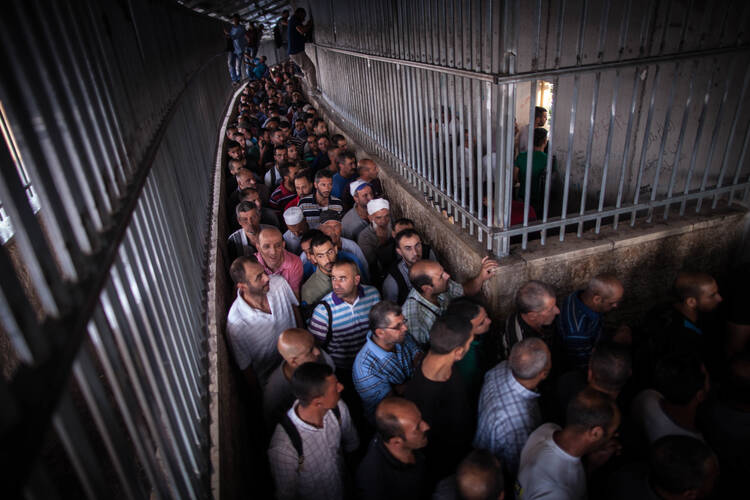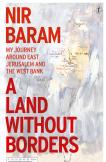The facts on the ground in the West Bank
In A Land Without Borders, the Israeli journalist and novelist Nir Baram travels through the West Bank and East Jerusalem to “examine, as frankly as possible, the connection between [his] own political views and the West Bank reality.” While it is not surprising that much of the world misunderstands the conflict, Baram contends that even most Israelis do not actually understand the reality for those in the West Bank. But the reality is nuanced. It’s messy. People are imperfect. Solutions are imperfect. Baram’s journey becomes our journey and Baram our guide. He introduces the reader to disparate voices in the seemingly unending debate about Israel and Palestine coexistence.
His interview subjects range from Jewish settlers in the West Bank to Israeli Palestinians in Jerusalem. Some of the people Baram speaks to are extremely close to the conflict, having lost family members, their livelihood and a sense of identity. Others are removed, rarely if ever interacting with those on the other side. We are forced to question the notions of home, land and nation. Baram allows the words of those interviewed to shed light on the injustices imposed on the Palestinian people, including lack of voting rights, property ownership and the freedom of movement. We question what we thought we knew about the situation and learn troubling new truths. The Israeli state builds walls straight through the middle of neighborhoods. The walls divide families. Israeli settlements prohibit Palestinians from tending to their land. Israeli checkpoints restrict Palestinians from accessing their job sites. Joblessness, or a lack of opportunities, might fuel an act of violence more than religious differences.
One Jewish student concludes: “Their rights are under our control. The Arabs deserve human rights but not civil rights.”
Preferred solutions vary, and some people propose no solution at all. When Baram prods some of the Jewish people he speaks to about Palestinian rights, it becomes apparent that a sense of ethnic heritage blinds some into believing that land is more important than people. Baram asks, “So you’re willing to give the Palestinians everything except their own state or the right to vote in a binational state?” His counterpart, a world-traveled Jewish settler, responds, “That’s a fairly accurate definition.” Some other Jewish subjects go on to voice concern for their Arab neighbors but with a clearly superior air, like colonial occupiers throughout history: “Today the safest place for Arabs in the Middle East is [Israel]. Even under occupation, their lives are freer and more democratic than in the Arab world.” One Jewish student concludes: “Their rights are under our control. The Arabs deserve human rights but not civil rights.”
Baram speaks to his fellow Jewish Israelis, debunking the notion that the Israeli state can be a scapegoat for shameful practices and treatment of Palestinians. One of Baram’s Jewish interviewees notes, “We have to accept the existence of the Palestinian nation, and we played a part in their tragedy.” Opinions are learned at an early age. Baram interviews a group of Jewish children. After reading a report to the children about a group of Palestinian children who were killed in a bombing, the young Jews had differing opinions, but one asserted: “There’s a justification, of course. You know how they said the I.D.F. shot at children on the beach in Gaza for no reason? Turns out kids were firing rockets on Israel.” And another responded, “Ninety-five [percent] of them will be terrorists. They learn to hate Jews in school.”
Although Baram gives us a disturbing account of the current reality, he remains optimistic. He pushes his interviewees (and himself) to imagine the future. Given what we’re learning about the situation on the ground, what does the future look like? What should it look like?
There are also several interviews that remind us that Jews and Palestinians are not monolithic groups. Although Baram urges Jews to refrain from blaming the state for all offensive policies toward Palestinians, not all Jews are actively contributing to the occupation, and many are opposed to it. Likewise, Palestinians are not off the hook entirely. Baram questions a former member of Hamas, who had spent time in prison for attempting to detonate a car bomb in Jerusalem in 1998, about his ideas for a solution. “There is no solution except for the Jews to go back to the countries they came from and for everyone to fulfill their rights in their own countries.” Baram counters, “So you want to convince more than six million Jews, many of whom did not come from Europe, that the solution is for them to emigrate to Europe?” Sometimes the more we understand about a conflict, the more difficult a viable solution is to propose.
After reading A Land Without Borders, I know more about the reality in the West Bank and East Jerusalem, but I am no less confused. And maybe that is the lesson. Baram walks us through a complex reality, not to simplify or explain it, but to experience it. He delivers a more complete picture, which is a good starting place. “It’s difficult to talk about a solution when you have no idea what the problem you are discussing looks like.” Principally, the reader questions the concept of “the other.” And this examination should appeal to all people, not only those in Israel and Palestine.
This article also appeared in print, under the headline “Facts on the ground,” in the October 2, 2017, issue.











